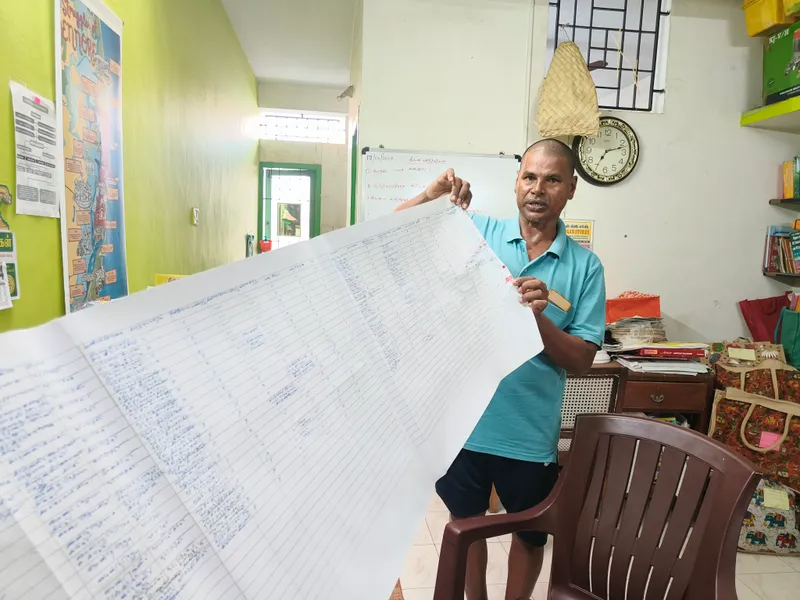This fisherman’s indigenous knowledge helps create a study on changing seas
S Palayam of Chennai has studied the ocean—its winds and currents—for seven years. His first-hand experience and observations are now part of an important database.
“For us, the ocean is our mother and the wind, our father,” says S Palayam—fondly called anna (brother). At 60, he is a treasure trove of stories about the sea.
At the Urur Olcott Kuppam, a fisher hamlet in Chennai that has been his home for the last 60 years, people consult Palayam for several things: is it a good day to wash and dry clothes; will the winds be kind on that given morning; will the Kola (Gar) fish ever populate the Bay of Bengal as abundantly as they used to until some years ago.
Most recently, Palayam was called to comfort a family of three who were convinced that “a ghost in the sea” was following them all the way from Golden Beach to Besant Nagar Beach in Chennai.
He was woken up by a call at night and asked to guide the rather bewildered family that had been spooked by a light on the surface of the waves on this moonless night.
They had instantly assumed it was paranormal.
Palayam knew what it was even before he saw it. To demonstrate, he dug deep into the sand on the shore until seawater emerged. He then stirred it slightly and the light reappeared.
“It’s a luminescence in the sea that we call ‘Kamaru’. It is caused by the ‘Olini’ —or the current from the deep sea to the land —which brings certain varieties of deep sea fish to the surface. When the moon is out, they go back to the depth of the ocean,” he says. “This is the best time for us to use floating nets, which are ideal to catch these varieties of fish.”
Scientifically speaking, the glow is caused by the algae bioluminescent phytoplankton, which converts its chemical energy into electrical energy causing the luminescence.
While Palayam may not relate to the scientific reasoning behind this phenomenon, he knows the winds, currents, and the moon cycle that precede it.
For the fisherfolk, this knowledge is life-sustaining. And as writer, researcher and environmentalist Nityanand Jayaraman came to understand, it was the kind of indigenous, generational wisdom that could complement scientific marine study quite practically, as most of Palayam’s knowledge stems from the lived experiences and observations of being a fisherman.
Indigenous knowledge in research
Jayaraman has frequently joined Palayam from September 2018 to October 2023, arriving at the crack of dawn to explore the sea. They have spent these early hours observing the winds and currents, noting their shifts with the changing climate and the impact of this on fish movement and migration patterns over the years.

Palayam's study of the changing winds and currents in the Bay of Bengal has been recorded over the last seven years.
Their observations culminated in a study titled ‘Sea Changed; Seasons Changed: A Fisher Science View of Climate Change’. The research brought together Jayaraman’s journalistic curiosity and Palayam’s understanding of the sea to make vital recordings.
Among other things, they point out that, the transition from ‘Kachan’ (southwest winds) to Vaadai (northeast monsoon) season used to happen in the middle of the Tamil month of Purattasi (which falls between the end of September to early October).
Influenced by northerly winds and currents, Purattasi seas are meant to be calm, blue, clear and conducive for night-time fishing using nets, and hook-and-line fishing for barracuda fish.
However, what was usually a highly productive month has been a washout throughout the study period because of the delayed onset of northerly winds and currents.
“All of the fishing community has a basic level of expertise; knowledge that is gained through experiential pedagogy. Some of them are knowledge keepers, and others like Palayam are knowledge makers. They innovate and change their practices with the changing times and situations, and pass it on to future generations,” says Jayaraman.
“It is never a question of comparing fisher science with Western institutional science. They are two different ways of learning,” he adds.
Jayaraman says that it is equally vital to understand that the traditional knowledge of the fisherfolk isn’t fossilised or ‘mystic’. It is rather a methodical language gained by ‘doing’, that is, venturing into the sea day in and out for generations, and learning how to prepare for it.
An immersion into stories
Palayam and Jayaraman’s work, inspired by artist Parvathy Nayar’s moxie for water-based themes in her art has resulted in The Living Ocean—a hybrid experience that brings science, art and storytelling in a permanent exhibit at the Dakshina Chitra Heritage Museum in Chennai.
Nayar celebrated five years of Palayam’s study of the ocean and the winds to create her film, ‘Seaspeaker’, which takes viewers into his unique cultural repository of language, spirituality and science.
“Palayam Anna is both the protagonist of this film and the artist. He can bring a certain knowledge from the sea that metamorphoses into the art space - breaking down marine degradation and how it affects us - through his eyes,” says Nayar. “I felt the sea spoke to him, and I wanted to encapsulate this phenomenon through the film.”
The exhibition also features an installation of nets created by Palayam; an installation of lenticular work of endangered coastal birds from South India by Nayar’s arts initiative The Hasthtag Collective, and two sound installations - one of bird calls and the other of crashing waves - by artist Madhu Viswanathan.
For fisherfolk like Palayam, winds and currents are at the crux of every important decision. “Generally, winds are known to be eight. But we understand that there is a ninth one —the dangerous Kun Vadai —that is responsible for storms, lightning and heavy rains. To subdue this, we need the Thendi —the winds flowing from south to north,” he says.
He also categorises four currents: the Thendi, which is the southerly, the Vanni (northerly) the Meimiri (which flows from the shore to the deep sea) and the Olini (an extreme form of which is the Tsunami).
“On days that a storm is incoming, we recognise it by looking not at the sea, but at the sky on the opposite side, to detect flashes of lightning,” says Palayam. “These are important parameters we have learned through years of venturing into the ocean.”
Having retired from fishing to study the sea full time, Palayam says the fisherfolk’s knowledge of the marine ecosystem must be preserved, along with their local language used to describe it.
Edited by Affirunisa Kankudti






